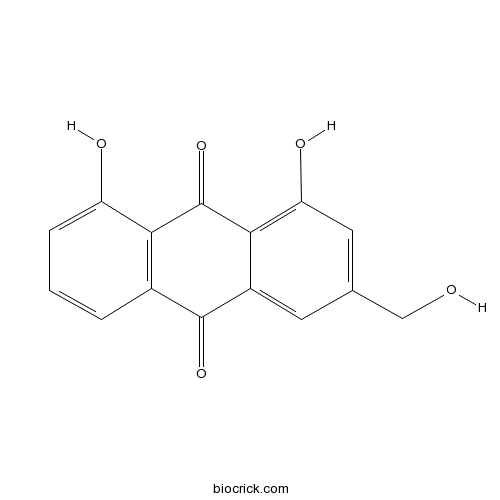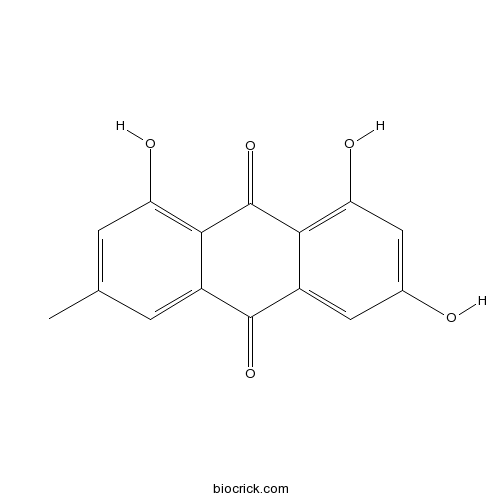Dendrobium fimbriatum
Dendrobium fimbriatum
1. The products in our compound library are selected from thousands of unique natural products; 2. It has the characteristics of diverse structure, diverse sources and wide coverage of activities; 3. Provide information on the activity of products from major journals, patents and research reports around the world, providing theoretical direction and research basis for further research and screening; 4. Free combination according to the type, source, target and disease of natural product; 5. The compound powder is placed in a covered tube and then discharged into a 10 x 10 cryostat; 6. Transport in ice pack or dry ice pack. Please store it at -20 °C as soon as possible after receiving the product, and use it as soon as possible after opening.
Natural products/compounds from Dendrobium fimbriatum
- Cat.No. Product Name CAS Number COA
-
BCN5947
Rhein478-43-3
Instructions

-
BCN5565
Aloeemodin481-72-1
Instructions

-
BCN5567
Chrysophanol481-74-3
Instructions

-
BCN5649
Emodin518-82-1
Instructions

-
BCN5663
Physcion521-61-9
Instructions

Four new glycosides from the stems of Dendrobium fimbriatum Hook.[Pubmed: 27798974]
Four new glucosides, named as gigantol-5-O-β-d-glucopyranoside (1), 9,10-dihydro-aphyllone A-5-O-β-d-glucopyranoside (2), ficusal-4-O-β-d-glucopyranoside (3), botrydiol-15-O-β-d-glucopyranoside (4), together with eight known compounds (5-12) were isolated from the n-BuOH extract of the stems of Dendrobium fimbriatum Hook. Their structures were elucidated by the analyses of spectroscopic data.
Cytotoxic bibenzyl dimers from the stems of Dendrobium fimbriatum Hook.[Pubmed: 25316316]
The bioassay-guided chemical investigation of the stems of Dendrobium fimbriatum Hook led to the isolation of seven first reported bibenzyl dimers with a linkage of a methylene moiety, fimbriadimerbibenzyls A-G (1-7), together with a new dihydrophenanthrene derivative (S)-2,4,5,9-tetrahydroxy-9,10-dihydrophenanthrene (8) and thirteen known compounds (9-21). The structure of the new compound was established by spectroscopic analysis. Biological evaluation of bibenzyl derivatives against five human cell lines indicated that seven of those compounds exhibited broad-spectrum and cytotoxic activities with IC50 values ranging from 2.2 to 21.2 μM. Those rare bibenzyl dimers exhibited cytotoxic activities in vitro and the cytotoxicity decreased as the number of oxygen-containing groups in the structure decreases.
Specificity and preference of mycorrhizal associations in two species of the genus Dendrobium (Orchidaceae).[Pubmed: 23271631]
Dendrobium is a large genus of tropical epiphytic orchids. Some members of this genus are in danger of extinction across China. To investigate orchid mycorrhizal associations of the genus Dendrobium, plants from two Dendrobium species (Dendrobium officinale and Dendrobium fimbriatum) were collected from two habitats in Guangxi Province, China, and clone libraries were constructed to identify the mycorrhizal fungi of individual plants. A low and high degree of specificity was observed in D. officinale and D. fimbriatum, respectively. Phylogenetic analysis revealed that the majority of Dendrobium mycorrhizal fungi are members of the Tulasnellaceae, but, in some plants, members of the Ceratobasidiaceae and Pluteaceae were also found. In D. officinale, individual plants associated with more than three fungi simultaneously, and, in some cases, associations with five fungi at the same time. One fungus was shared by individual plants of D. officinale collected from the two habitats. In D. fimbriatum, only one fungal partner was found in each population, and this fungus differed between populations. The two species of Dendrobium sampled from the same habitat did not share any fungal taxa. These results provide valuable information for conservation of these orchid species.
Identification of medicinal Dendrobium species by phylogenetic analyses using matK and rbcL sequences.[Pubmed: 20140532]
Species identification of five Dendrobium plants was conducted using phylogenetic analysis and the validity of the method was verified. Some Dendrobium plants (Orchidaceae) have been used as herbal medicines but the difficulty in identifying their botanical origin by traditional methods prevented their full modern utilization. Based on the emerging field of molecular systematics as a powerful classification tool, a phylogenetic analysis was conducted using sequences of two plastid genes, the maturase-coding gene (matK) and the large subunit of ribulose 1,5-bisphosphate carboxylase-coding gene (rbcL), as DNA barcodes for species identification of Dendrobium plants. We investigated five medicinal Dendrobium species, Dendrobium fimbriatum, D. moniliforme, D. nobile, D. pulchellum, and D. tosaense. The phylogenetic trees constructed from matK data successfully distinguished each species from each other. On the other hand, rbcL, as a single-locus barcode, offered less species discriminating power than matK, possibly due to its being present with little variation. When results using matK sequences of D. officinale that was deposited in the DNA database were combined, D. officinale and D. tosaense showed a close genetic relationship, which brought us closer to resolving the question of their taxonomic identity. Identification of the plant source as well as the uniformity of the chemical components is critical for the quality control of herbal medicines and it is important that the processed materials be validated. The methods presented here could be applied to the analysis of processed Dendrobium plants and be a promising tool for the identification of botanical origins of crude drugs.
Development of microsatellite markers in Dendrobium fimbriatum Hook, an endangered Chinese endemic herb.[Pubmed: 21564654]
As an endangered endemic herb, Dendrobium fimbriatum, is under threat from numerous impacts. In order to analyse the genetic diversity and structure of this endangered species, we provide details of 10 microsatellite loci (out of 15 primer pairs designed) which showed polymorphic for D. fimbriatum. These loci were used to screen 25 individuals from across the species' geographical range. Ten loci were polymorphic with 2 to 19 alleles; three loci were monomorphic, while the rest produced no amplification fragments. These loci will be used to investigate population genetic structure, genetic diversity, conservation, and individual authentication in the endangered D. fimbriatum.
[Molecular identification of medicinal plants: Dendrobium chrysanthum, Dendrobium fimbriatum and their morphologically allied species by PCR-RFLP analyses].[Pubmed: 16268508]
To establish a simple method for molecular identification of original plants of D. chrysanthum and D. fimbriatum using molecular marker rDNA ITS region.
[Studies on the chemical constituents of Dendrobium fimbriatum].[Pubmed: 14515799]
To investigate the chemical constituents of Dendrobium fimbriatum Hook.


